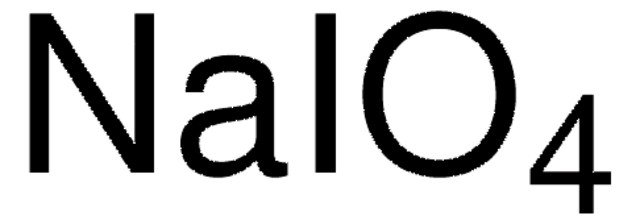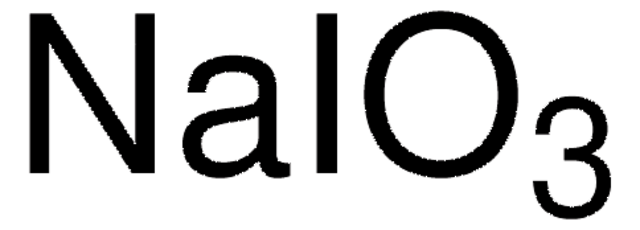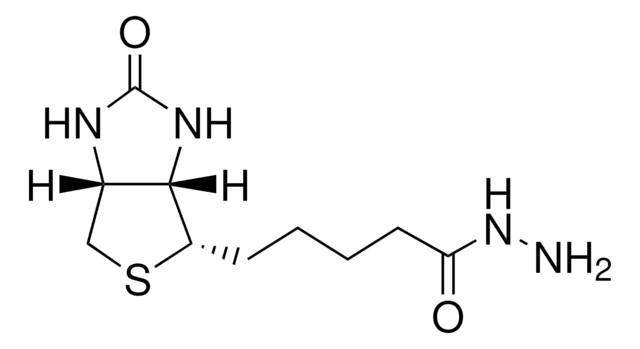S1878
Sodium (meta)periodate
≥99.0%
Synonyme(s) :
Sodium periodate
About This Item
Produits recommandés
Pureté
≥99.0%
Forme
powder
Pertinence de la réaction
reagent type: oxidant
pH
3.5-5.5 (25 °C, 107 g/L)
Solubilité
H2O: 50 mg/mL
Chaîne SMILES
[Na+].[O-]I(=O)(=O)=O
InChI
1S/HIO4.Na/c2-1(3,4)5;/h(H,2,3,4,5);/q;+1/p-1
Clé InChI
JQWHASGSAFIOCM-UHFFFAOYSA-M
Vous recherchez des produits similaires ? Visite Guide de comparaison des produits
Description générale
Application
- 1,2-diols to aldehydes or ketones via oxidative cleavage. Sulfides to sulfoxides in the presence of phase transfer catalysts.
- Diaryl, dialkyl, and aryl alkyl selenides to the respective selenoxides.
- Phenols and their derivatives to corresponding quinones.
- Acylphosphoranes to α,β-dicarbonyl compounds.
It can also be used in the:
- Selective alkene epoxidation and alkane hydroxylation,·
- Oxidation of carbohydrates.
- Iodination of aromatic compounds.
Caractéristiques et avantages
Mention d'avertissement
Danger
Mentions de danger
Conseils de prudence
Classification des risques
Aquatic Acute 1 - Aquatic Chronic 1 - Eye Dam. 1 - Ox. Sol. 1 - Skin Corr. 1C - STOT RE 1
Organes cibles
Thyroid
Code de la classe de stockage
5.1A - Strongly oxidizing hazardous materials
Classe de danger pour l'eau (WGK)
WGK 3
Point d'éclair (°F)
Not applicable
Point d'éclair (°C)
Not applicable
Certificats d'analyse (COA)
Recherchez un Certificats d'analyse (COA) en saisissant le numéro de lot du produit. Les numéros de lot figurent sur l'étiquette du produit après les mots "Lot" ou "Batch".
Déjà en possession de ce produit ?
Retrouvez la documentation relative aux produits que vous avez récemment achetés dans la Bibliothèque de documents.
Les clients ont également consulté
Notre équipe de scientifiques dispose d'une expérience dans tous les secteurs de la recherche, notamment en sciences de la vie, science des matériaux, synthèse chimique, chromatographie, analyse et dans de nombreux autres domaines..
Contacter notre Service technique












